-
Posts
2950 -
Joined
-
Days Won
28
Content Type
Profiles
Forums
Events
Posts posted by Rad
-
-
Nice outing. Maybe if you zoom in you can see us on Sloan in the 2nd to last shot. A perfect day to be in the mountains.
-
Thanks. Twas a great day out. There are definetely more lines to be had on that wall.
The SW face of Sloan, and this route in particular, has a lot going for it. The rock is steep, clean, featured, and readily protectable. The views and alpine wilderness ambience are outstanding. The route tops out on the summit of a spectacular peak. There is a good road to the trailhead. The approach and descent follow a good trail and obvious cross-country alpine routes. The descent passes the base of the route, allowing one to retrieve/cache extra food, liquids, headlamps, shoes, etc. The SW aspect means that the face likely melts early in the season and dries out fast after rainstorms. There is no bushwhacking (unless blueberries are wet) or glacier travel required, though snow may be hard. There is water along much of the approach. Competent 5.10 climbers should have no trouble doing this route car to car in a day. The 5.10+ crux on the first pitch could easily be aided if necessary. It should be fairly easy to bail off the giant ledge at 400ft if necessary.
Re-reading, it sounds like we scoped out one or more lines on the wall before choosing one. In reality, you approach from the side, so you can really only scope the first 80-100ft. The only info we had on rock past the first 100ft came from that Scurlock photo and the one of Alex. As they say, it's better to be lucky than good.
-
Trip: Sloan SW Face - Fire on the Mountain (FA/FFA)
Date: 8/30/2009
Trip Report:
Short version:
Fire on the Mountain: FA/FFA on the SW face of Sloan. 8 pitches, 5.10+, III+ (1100ft of technical climbing on steep, clean rock plus 500ft of scrambling to the summit). Blake Herrington and Rad Roberts.
Long version (photos and video by Blake Herrington):
Descending Sloan after a moderate jaunt up its West Face, AlexK and I gaped in awe at the sheer Southwest face of the mountain. Alex later commented, “Walking along the base of the SW face was like walking along the base of the Upper Town Wall at Index...line after line of really awesome steep granite rising directly from the steep slope vertically for many pitches!”
Alex looking up at the SW Face of Sloan, 2006 (new route starts just off the frame to the right.)
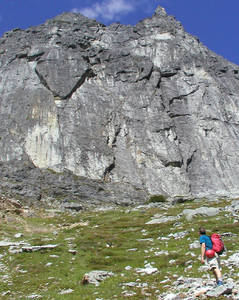
With a bit of hype and a few Scurlock photos, I was able to convince Blake to take a shot at this worthy objective. Morning mists enveloped us as we coaxed my old car up FS4690 to the Bedal Creek trailhead. We walked through old growth forest and followed the cascading creek to the base of the immense West face of Sloan. Although this impressive face surely holds more good lines, we continued on to the SW face.
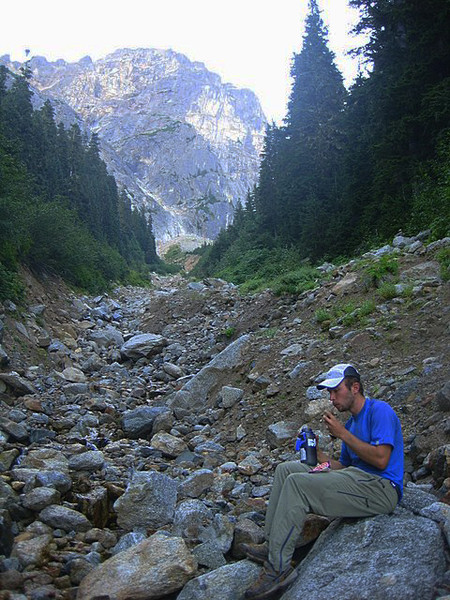
The mists burned off as we left the forest for heathery meadows and ripe blueberries, wasting precious minutes on the jaws of a giant.
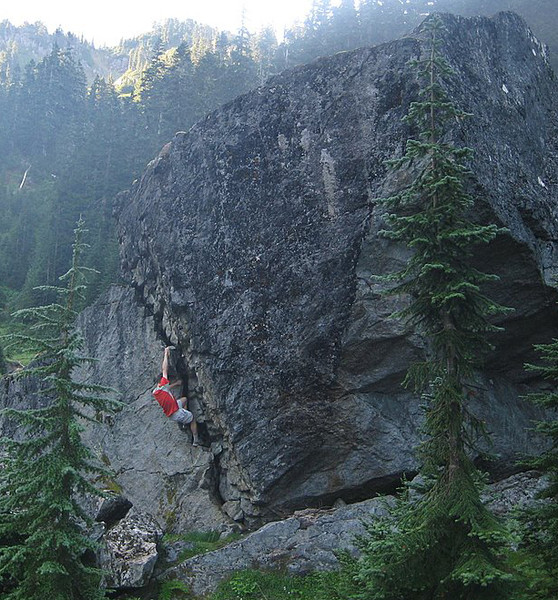
Upon cresting the final ridge, I was pleased to see that the SW face looked just as steep and clean as I’d remembered. Several lines looked good, though they would need some gardening on the first pitch. We chose a prominent left facing corner leading to a chimney (upper right in the photo below) and some thin cracks up a face.
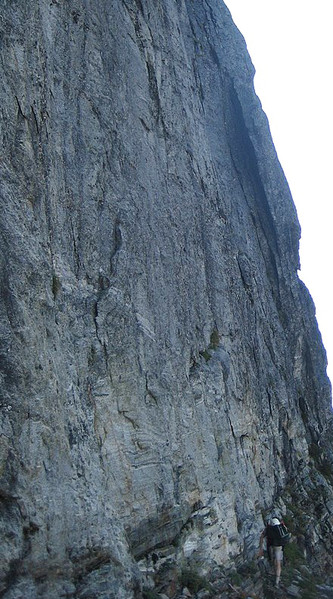
Blake getting dressed for work. We should all be so lucky
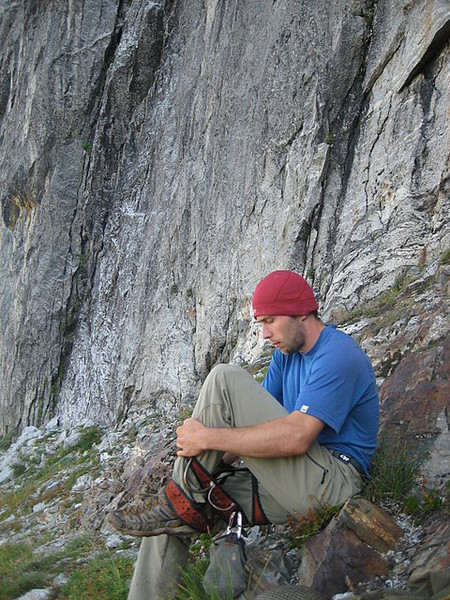
I asked for and was granted the opportunity to lead the first pitch. I did a little gardening at the start, but the rock was quite solid and protectable. My calves started to burn as holds ran out and the corner turned into a chimney, but an exit onto a small stance provided a rest and revealed a series of spectacular, clean finger cracks soaring straight up the wall. Working up these, I felt the fire spread to my forearms. I rested when possible and carefully contemplated each tricky section, hoping to honor this fine line in good style. Blake was very patient. Fortunately, the rock and gear were solid so it was easy to go for it. I cranked through the crux and savored juggy moves over a final bulge to a belay atop a pillar, whooping with delight on completing the onsight.
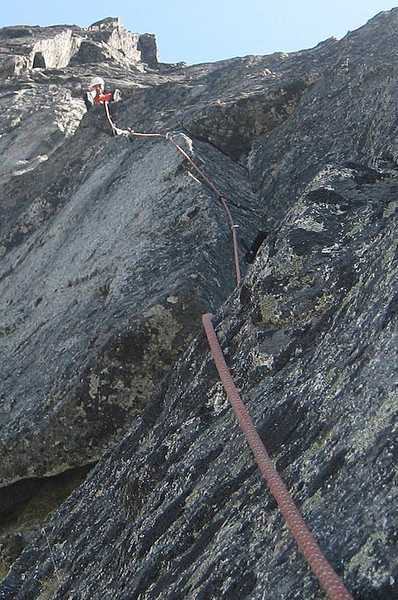
Blake joined me, casually shooting video just after the crux.
[video:vimeo]6387846
This would prove to be the hardest pitch of the day, perhaps 5.10+ or 5.9++ or 5.11-. Ratings reflect only one aspect of the experience, and often they distract from the essence of a climb. For me, this pitch alone was worth the price of admission, with 45m of sustained, outstanding, well-protected (I placed about 13 pieces!) climbing on solid rock, with multiple 5.10 sections and a really fun crux.
Blake then headed up the next pitch, linking clean vertical and horizontal cracks and a few face moves to a belay at a ledge.
[video:vimeo]6387982
This section was reminiscent of the upper pitches of Loving Arms on the Upper Town Wall at Index and various routes on Lover’s Leap.
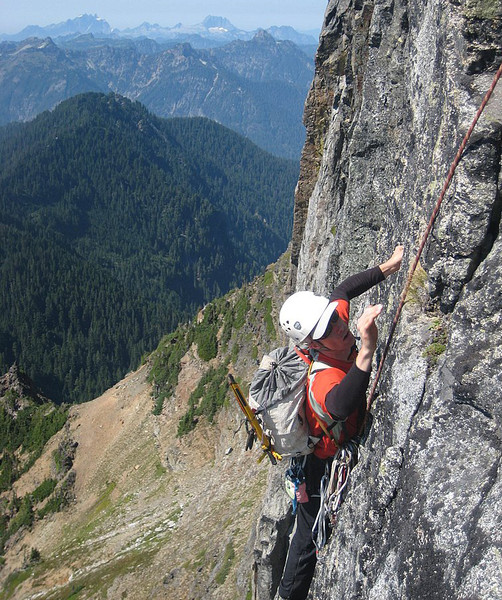
I let Blake take the third pitch as the second pitch was rather short and I’d poached the best pitch from him on Tower a year ago. P3 started in a finger crack and then headed up a series of golden flakes, dikes, and buckets.
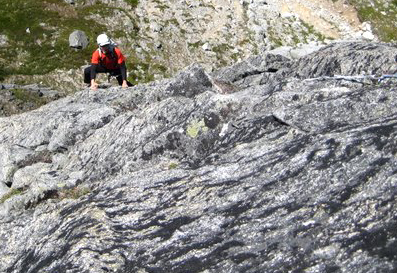
I did a hand traverse left under a large roof to move the belay
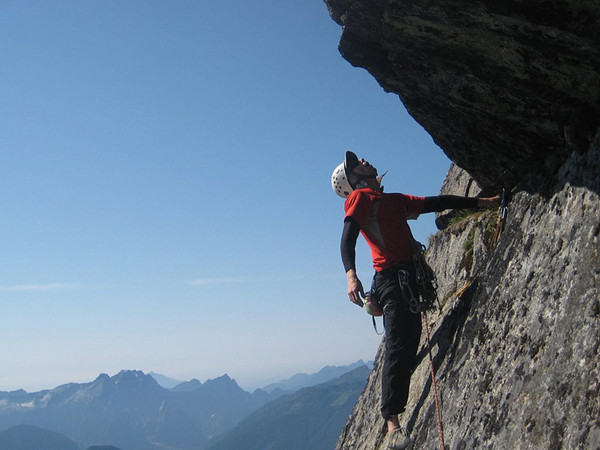
and then shot up a steep right-facing corner, brushing lichen off key footholds along the way. The angle eased a bit and I cruised up to the giant heather ledge that splits the face.
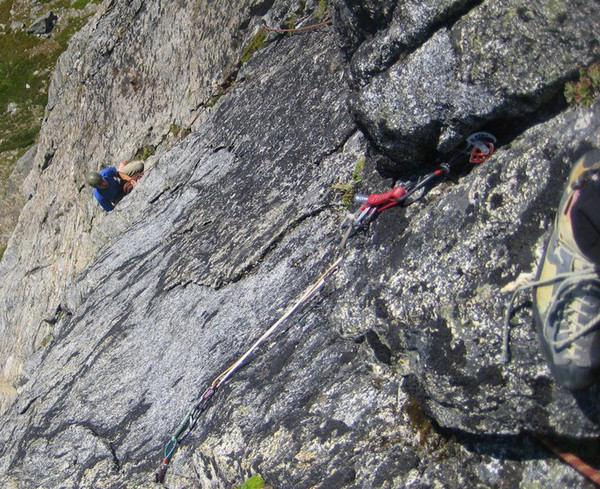
Lots more steep, clean, featured rock loomed above us, and we were shocked to see it was already 4pm. Go time. Blake floated up a left-leaning crack system and a perfectly clean OW corner to a belay on a pillar. There we found two old pins. Someone had come this way before (see comments below). I danced up a steep face peppered with protruding dikes, managing to sling a giant knob and slot a cam in a small crack. The end of this pitch featured a steep finger crack in a corner with an old pin. I clipped this piece of history, but images of it failing motivated me to crank through without weighting it.
Entering the crux of p6 (note slung knob in foreground)
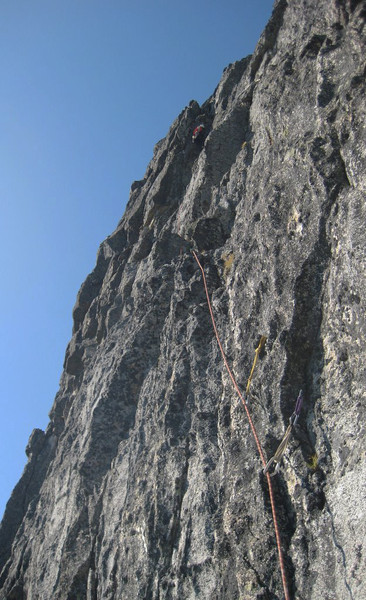
Sunshine, silence, and sweeping views of the Mountain Loop and Monte Cristo peaks enveloped us. We savored the pristine wilderness setting.
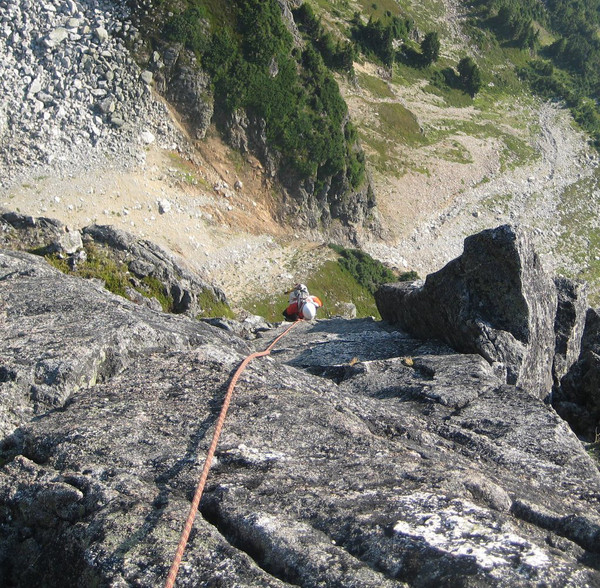
Blake then lead a 60m rope-stretcher to a stance just below another large ledge. Dehydrated and fried from hours of exertion in the sun, I offered Blake what we hoped would be the final lead of the day. It didn’t disappoint, with a hand crack around a roof bulge and a rising traverse on positive flakes to a final corner. We unroped. It was 7pm. Our water was long gone, and my moxie had long since moseyed.
Although I had descended Sloan before, I didn’t relish the idea of rappelling and down climbing in the dark with one headlamp between us. But Blake had never been to the summit, and we needed to complete the route, so we stashed our gear and scrambled to the airy summit. We signed the register, snapped a pic, and turned to head for the stable.
Note moon in background.
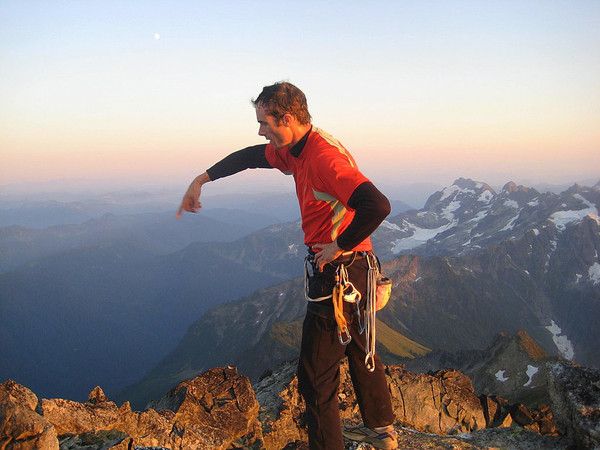
I staggered heavily (Blake scampered lightly) back down to our packs and we admired a stunning sunset as we started the rest of the descent.
We rapped to the sloping ledge as twilight turned to night, but the moon cast its gentle glow on the descent slabs and the air was perfectly still, as if Sloan were gently ushering us back down to safety. Our ropes just barely reached the snow, but it was quite hard and our tennis shoes, one ax, and lack of crampons didn’t inspire confidence. Blake chopped a bollard and we rapped down to lower angle snow. The sound of running water drew us to a small waterfall of snowmelt where we drank deeply and split a Theo chocolate bar, smiling in the moonlight.
We retrieved our packs, including my headlamp, and headed toward the trailhead. But there was still one more obstacle: BLUEBERRIES! Evening dew had started to collect on the blueberry bushes at the top of the open slopes of the Bedal creek basin, and our feet skidded out each time we tried to take a step. Glissading seemed possible, but test runs showed the acceleration rates would be more like hard ice than soft snow. The ground was very hard and there was no way to hang onto the wet plants. Self arrest would be impossible. Death would be swift and sure.
I could see the headline already, “Climbers die on blueberry slope.” I pictured the deadly rabbit in Monty Python’s Holy Grail. We’d climbed a striking new route but been bested by some damp blueberry bushes. Actually, I’m OK with that. We decided to stick to the dense, prickly evergreen shrubbery on an adjacent ridge. We thrashed down that and rapped off a 4ft pine when we got cliffed-out above more evil blueberries.
The remainder of the descent went smoothly. The Darrington payphone ate my quarters while trucks of teenagers cruised the minimart in the wee hours. We drove to Arlington through misty fields, wolfed down tasty food at Haggen, and headed back to Seattle, arriving after 3am. My body attended morning work meetings, but my spirit was still in the mountains.
When the rains settle upon us and sun-kissed alpine rock is removed to daydreams, this is the trip I will replay again and again. Thanks for a great outing Blake, and for giving me the first pitch, the last swallow of water, the only ice ax on the hard snow, and good conversation to pass the hours on the trail.
………………
Fire on the Mountain, 5.10+, III+, 8 pitches, 1100ft of technical climbing and another 500ft or so of scrambling to the summit. All free, ground-up, onsight.
The route starts in a prominent left-facing corner that turns into a chimney. This is about a hundred feet right of a prominent right-facing corner, and 200ft right of a vegetated crack leading up the diamond feature in the photo with Alex.
Pitch 1: Tinderbox. Start in the obvious left-facing corner below a chimney. Stay right to avoid vegetated cracks at the top of the chimney, and step right to a small stance. Climb straight up finger and hand cracks to a belay at a decent ledge. 45m, 5.10+.
Pitch 2: Lightning strike. Move right to a pair of hand cracks in a corner, ascend the right one and hand traverse right to a small stance. Link face features and small cracks to a good ledge and a belay. 33m, 5.10-.
Pitch 3: Bucket brigade. Start up a thin crack and then move onto a face with golden buckets, flakes, and edges. Ascend a prominent corner under an OW roof crack and then hand traverse left under a giant roof to a belay stance out left. Future parties may choose to link p2 and p3. 34m 5.10-.
Pitch 4: Controlled burn. Delicate moves up a right facing corner lead to friendly flakes and dikes and a giant heather ledge that bisects the SW face. 40m, 5.8.
Pitch 5: Firebreak. Ascend a left-trending crack system near the top of p4. This leads to a clean ramp and a stellar golden dihedral with an OW crack (one #4 useful here). Finish on a pedestal near old pins and some cracks. 45m, 5.9.
Pitch 6: Alpine ladder. Scale a steep face on amazing dikes, follow the ladder leftward up hero climbing, and finish up a steep corner with a pin. 40m, 5.10.
Pitch 7: Smoldering embers. Shoot straight up the featured face to a giant heather ledge. 63m, 5.7.
Pitch 8: Final flare-up. Ascend a hand crack that jogs left around a small roof. Continue up cracks, trend left on positive flakes, and finish up a corner to a ledge. 45m, 5.10.
Scamper up to the obvious corkscrew route trail. Change into comfortable shoes, stash gear, and scramble unroped to the summit.
Beckey lists a route on the SW face, but what he calls the SW face is more like a route that starts on the South face, crosses a ridge mid-height onto the SW face, and follows easy ground to a shoulder. This is very different from what we experienced.
Based on the position of the few pitons we encountered, we believe someone climbed p5, p6, and p7 at some point, aiding through the steep finger crack crux on p6. We’d be interested to hear if anyone knows more about the nature of that route. The condition of p1, p2, p3, p4, and p8 suggests they had not been climbed prior to our ascent.
I've attempted to draw our line on a classic Scurlock shot. Red is roped climbing on p1 to p8 and green is unroped scrambling to the summit.
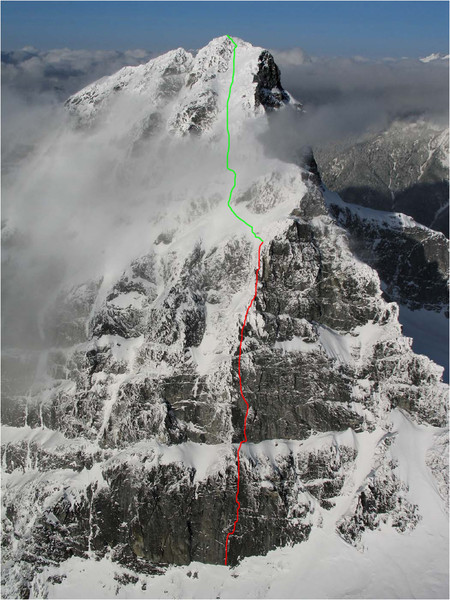
Gear Notes:
Stoppers work particularly well, including a few micronuts. We brought double cams to #3 camalot and one #4 camalot and used it all. We took a few pins but never needed them. The OW on p5 might take a #5 or #6 but Blake did fine without them. A single 60m rope is sufficient. An ice ax might handy for the snow. Go get some!
Approach Notes:
Approach:
Bedal Creek trail to the basin below the West Face. Ascend Blueberry Hill to a treed shoulder, traverse shoulder briefly, enter the basin below the SW face. The route starts in a prominent left-facing corner that turns into a chimney. This is about a hundred feet right of a prominent right-facing corner, and 200ft right of a vegetated crack leading up the diamond feature in the photo with Alex above. Perhaps 2 hrs from the car to the base of route.
Descent: Follow the corkscrew trail around to the South face, and down climb or rappel an obvious gully to a giant ramp. Descend eastward down the ramp until able to do a single rope rappel to the snow. Traverse toward the South shoulder, cross over this, and descend back to the base of the route. Retrace the approach back to the Bedal Creek trailhead.
-
 1
1
-
-
Yes, cool list Blake. A new Select-type guide would be in order. CC.com route wiki may provide one mode of dissemination.
The grade IV defn of 'all day' is pretty vague. Lynn Hill did the nose in a day, and others may take all day to do Dierdre. Instead just list a the number and difficulty of pitches (8 pitches, 5.11- vs 17 pitches 5.6 and/or length (500ft, 1500ft, 4000ft).
-
I think (and it is just me) that giving people shit in public (like the Internet) about what ever they do climbing, short of fucking up the rock or getting someone hurt is really disrespectful of their accomplishments.
I agree 100%. This illustrates why plenty of climbers want nothing to do with cc.com
-
...Just because it has been done in the past does not make it something I would do.
Then don't do it and stop trying to impose your own ideas on others.
-
big deal anyways; a rose by any other name?
This is what it's all about: a great route is a great route. Period. btw, whoever freed the .12/11c roof on CBR west face didn't rename the whole route., right?
Not sure who gave Cobra crack it's name, but I suspect it was Berthod. He and Trotter were both working the line and cheering each other on. When Trotter sent the FA when Didier was injured, Didier was there to encourage him. Trotter didn't rename the climb.
So back to your quote, Trotter summed it up nicely when he said about Cobra, I don't care if mine was the first ascent, the tenth ascent, or the hundredth ascent. It's about a relationship between a climber and the rock. I'm just glad that it's there for me to do...that it's there for everyone to do. GREAT ATTITUDE.
The few wimpy routes I've developed I strive to create something that other people will think is great. I'll freely admit that I succumb to that pride of authorship thing and want to do the FA after investing a lot of effort in cleaning and protecting a line (if it doesn't go trad), but maybe that pride of authorship drives me to do my best to generate a route others will think is great.
-
no bolts on roof crack, or anywhere else except belays, i believe.
a correction has been sent my way: someone lead out first, fell, left gear in place, then tom fired the pitch.
they continued to the top of the climb, rp'ing the rest of the pitches as well.
So the bolts were removed? That sounds like a good thing. Still raises interesting questions. Bolt to rehearse and then remove bolts to send on gear?
Awesome send. I'm sure many of us would love to see pics or video if such is available. Hint hint
-
tom red-pointed, while placing all gear on lead, the first free ascent of the roof crack on what has been called The Tempest. He called it Full Tilt, and it truly seems to be one of the unique and proud crack lines found anywhere.
Congratulations on a very impressive send. It's great to hear about Washington alpine routes that can stack up to the best Yosemite and Squamish have to offer.
You say gear, but wasn't the pitch roof, which takes solid cams all the way, bolted from top to bottom? So maybe you mean quickdraws were placed on bolts on lead (gear was just quickdraws)?
When is it ok to bolt cracks that take good pro, particularly on previously established lines? When is it not ok? I suspect this saga has more chapters to come. I look forward to hearing when someone, perhaps a hot local, goes Eric Decaria on it and sends without clipping the bolts. If Didier Berthod were here he'd do it and then chop the bolts and keep them as souvenirs. But I digress. Congrats on an awesome effort and send.
-
Most of us have had ugly one or no lamp descents. Glad it wasn't worse. Maybe if you'd had a rappel accident on the bolted slab rap in the middle of the Asgard descent...
-
Shhh! The police dogs are sniffing at your door right now.
-
Scary that is!
Zinc coated or anodized or any other anti-rust coating makes me nervous, and this illustrates why. Basically if the coating fails in any one spot then the interior can rust away but you don't really know it's happening because the non-rusting veneer keeps it hidden. Kind of like an old tree that's rotting on the inside even though it looks solid and healthy from most angles.
Stainless is the only way to go IMHO.
-
In 2008 North Cascades Park rangers responded to 11 serious incidents. Four of the incidents were mountaineering related. This year is already on track for several times that number.

-
Well, the interweb ate my response. Here's the short version (add IMHO in front of each):
- I don't see technical routes as better than non-technical routes. Just different.
- I love wild places as much as anyone, but it's hard to find time as a working dad to get out into the mountains for more than a day or two at a time. I look forward to sharing these places with kids when they are older. For now, we'll poke around in creeks and woods closer to home, just like I did as a kid.
- There's no such thing as a bad TR, and TR quality has little to do with the difficulty of a route. CC could always use more TRs.
Good luck with the varmints!
-
It's interesting to me to have a list of classic peaks instead of a list of classic routes. Example: classic peak list
I don't really understand the peak bagging thing. For me, climbing is more about the process than the endpoint. Case in point: ascend Mt Stuart via Cascadian vs the complete N Ridge. There may be other cases where the easiest route is a/the classic (Forbidden), but many where it is not.
Is it about cool locations? Getting off the beaten path? Ego and lists? I know some of you are into this. Anyone care to explain to the ignorant (me?)
-
Good job getting out into the alpine and getting it done. And thanks for posting a TR. There's no such thing as too many TRs here.
-
We don't know how hard the bombay is as we didn't do it. It looked crumbly with poor feet and it is short. Climbing the face seemed like a more natural line. It's a bit runout but probably was only one 5.9 move and then easier than that up to the step across, which is protected.
Not sure where this wide crack is you mention. The part that was awkward was the wierd ramp with flaring jams and dirt/needles and the sheer drop to the left. One move involved crimping on a small feature, reaching way up to undercling the underside of a chockstone wedged into the dirt, kneeling on sloping pine needles, and then standing up. Actually, it was fine. This just needs some gardening and then it would be as good as the rest of the route.
-
The Passenger is easily one of the best lines at the pass. Once you climb it, it's a great stand-by if you can't think of something new to get on at the spires.
So how does the Hitchhiker compare in terms of quality?
Great to see that big daddy brandon is still getting out.Not just getting out, he's getting it DONE!
-
Trip: SEWS - Passenger
Date: 8/15/2009
Trip Report:
Rain thwarted our plans to head for BC alpine rock, so we drove East on Hwy 20 instead. We spent a few hours dodging raindrops and getting spanked on Newhalem climbs on Friday. Here's an 11- on the left end of the wall, one of the easiest lines we found.
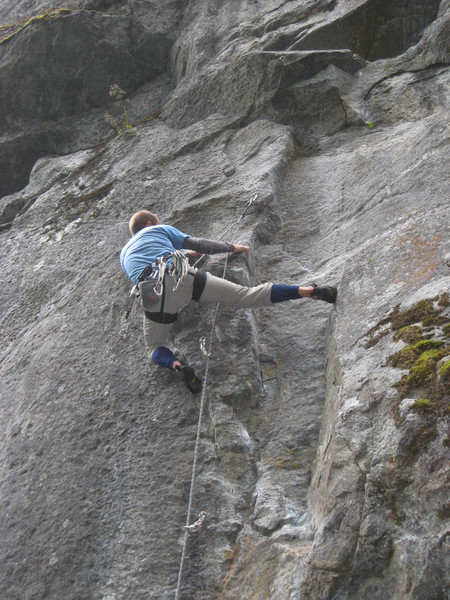
Clouds gave way to stars overnight, and we psyched up for the Passenger on SEWS. We neglected to print good descriptions from Mr. Tooth and Mr. Sun. Red Fred got us there just fine via the Blue Lake trail instead of from here:
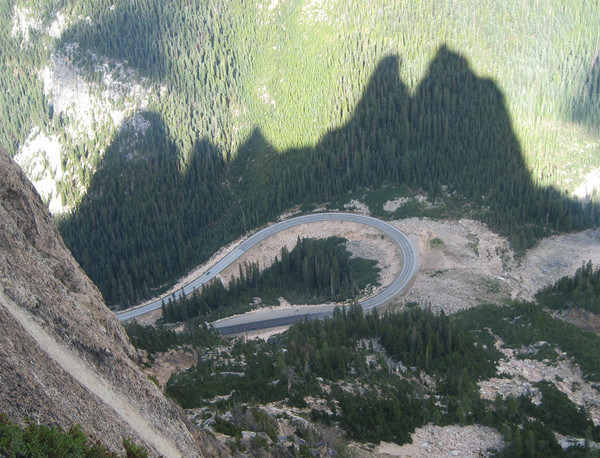
This is a truly OUTSTANDING route, with great climbing on every pitch on very solid rock. Lots and lots of sustained 5.10, but the 5.11 sections are short, protected, and could be aided. I'll let the pictures do most of the talking.
Descend from SEWS shoulder and traverse along the E wall until you get to an obvious large gully. Cross it and traverse the black line to the tree at the start of the route.
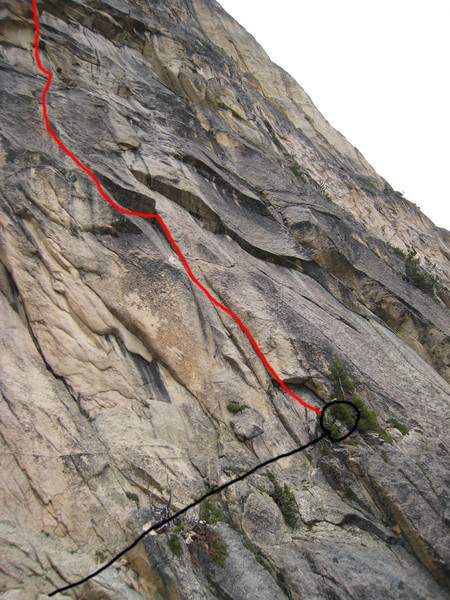
Looking up at the route.
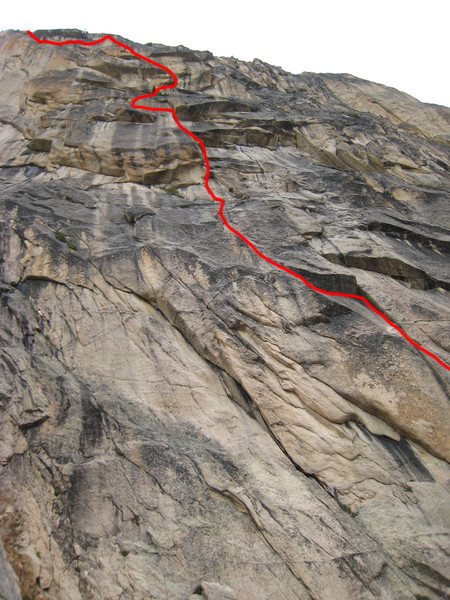
P1 is sustained finger crack goodness.
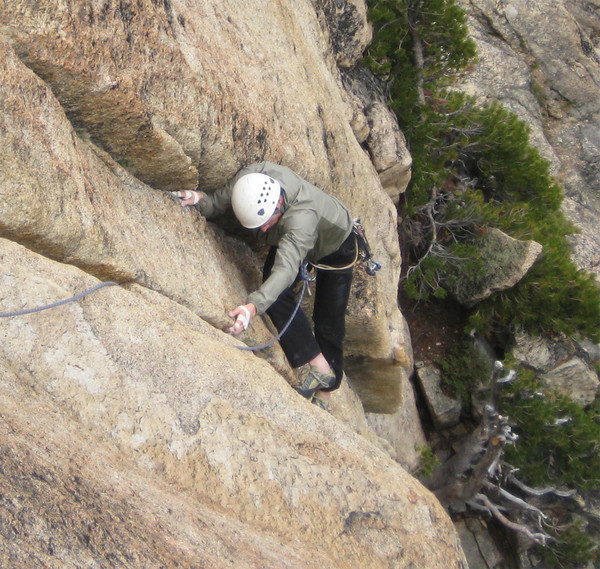
p1 roof (not the crux)
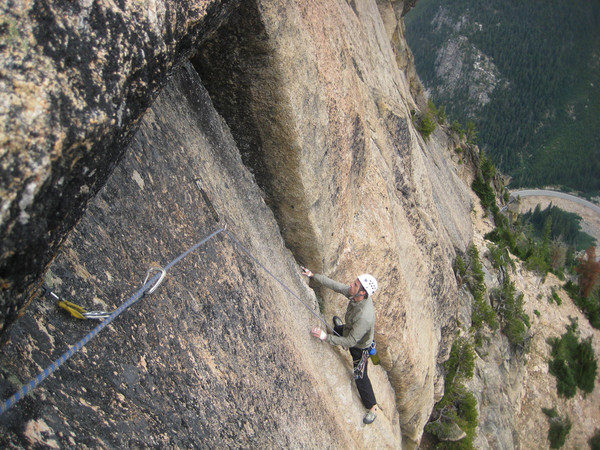
Hoping and groping on the roof on p2.
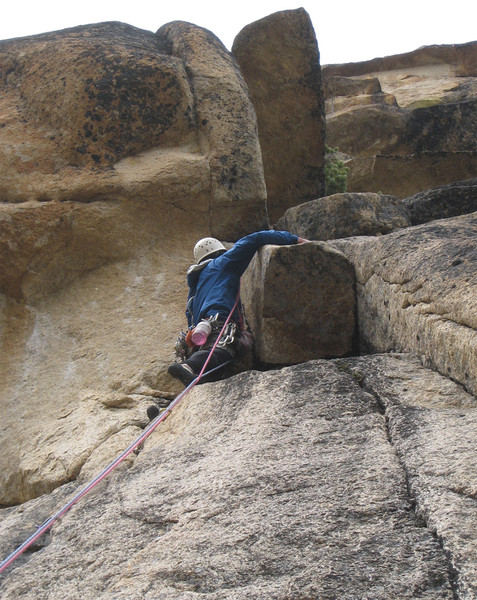
Wet fingerlocks leading up to a cool slot roof on p3.
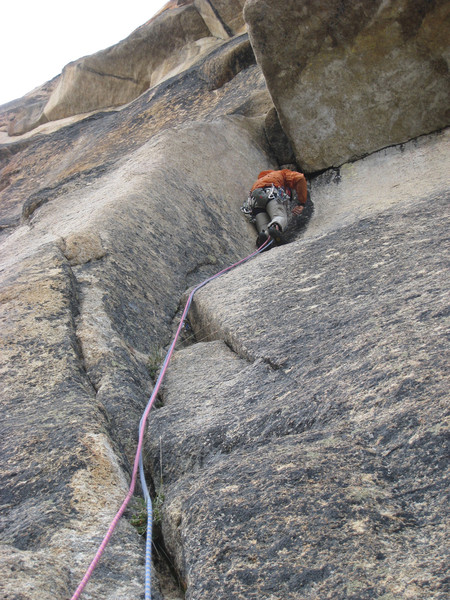
Fingerlocks from above.
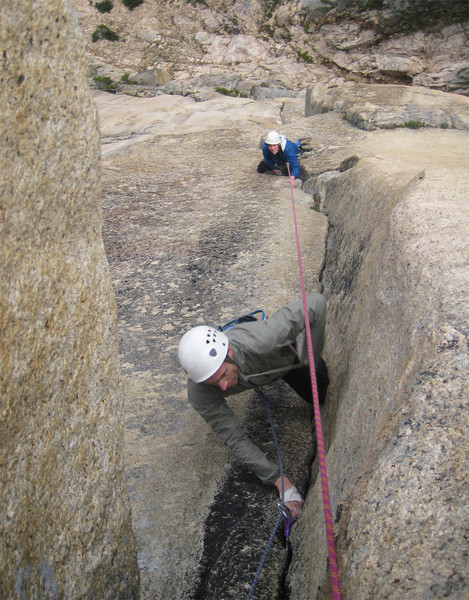
p3 roof slot
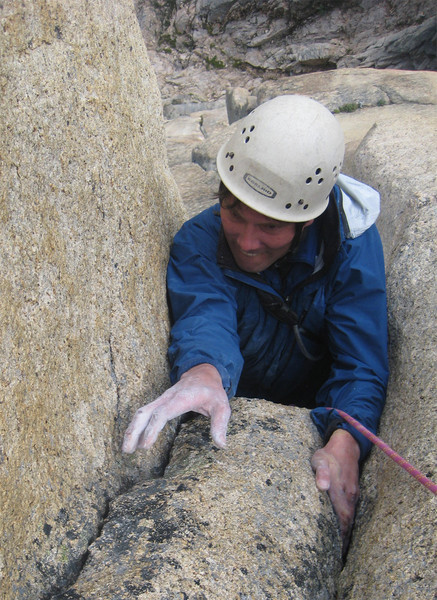
Slabosaurus.
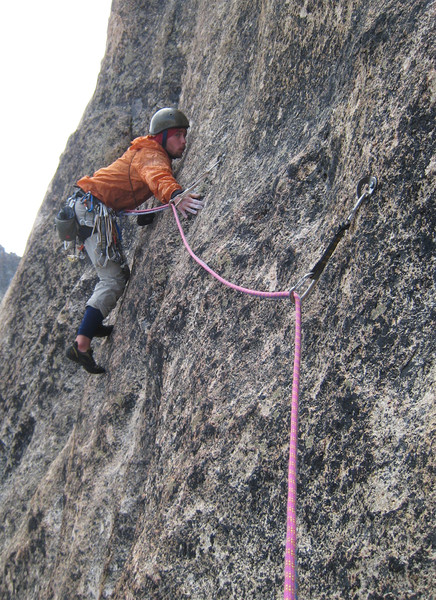
Knuckle mantle downclimb jingus
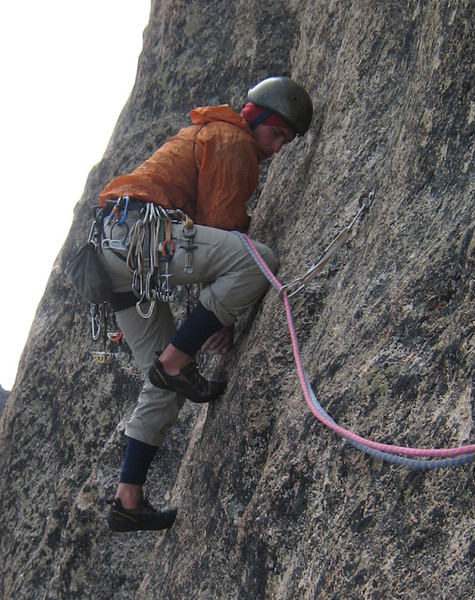
Smearing and smiling.
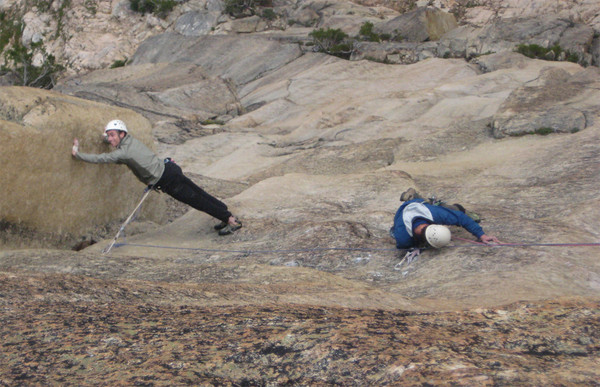
P4 past the crux.
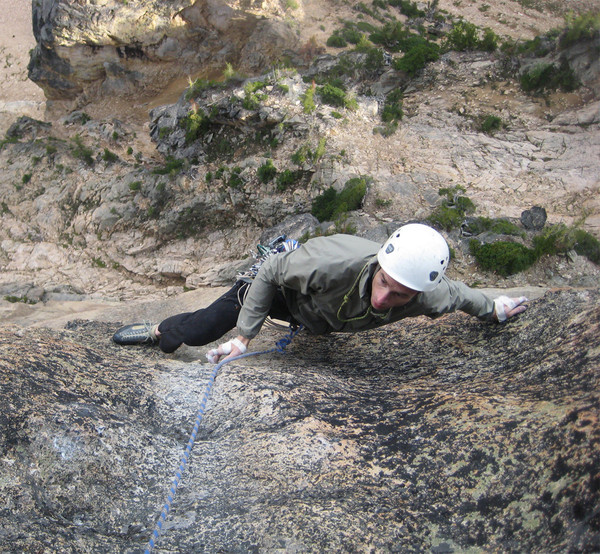
Cold belays bring out the bad dancers.
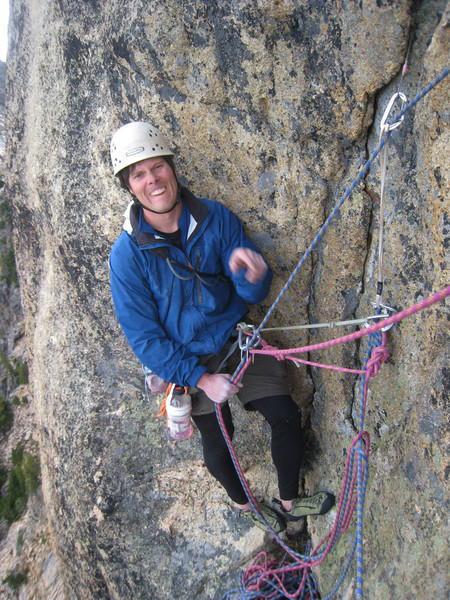
Traverse entry to the 5.10 ramp - others do the bombay chimney above this, we later learned.
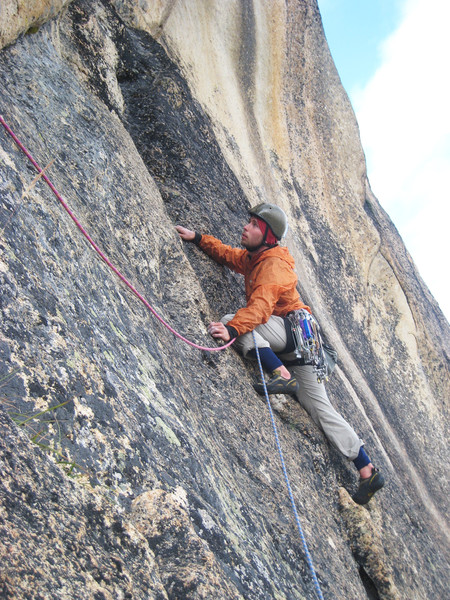
The icing on the cake.
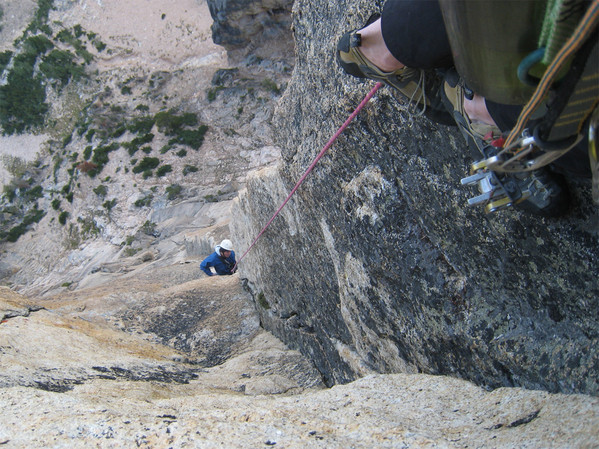
Awkward, wet, dirty, and very exposed moves on my lead. Still cool though.
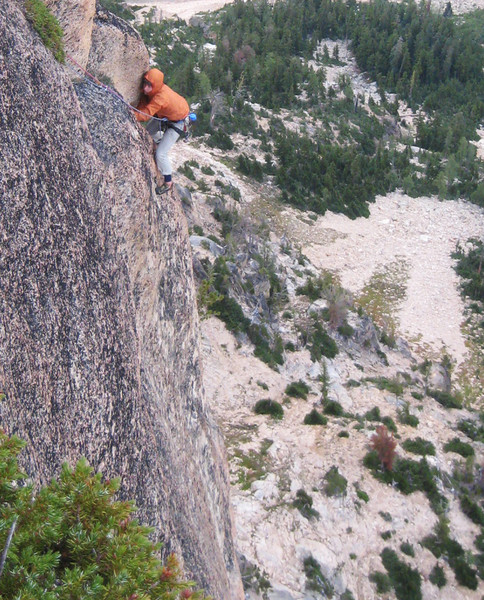
Make a leftward traverse to a tree and then across to the final section. Pray the stacked blocks don't fall out.
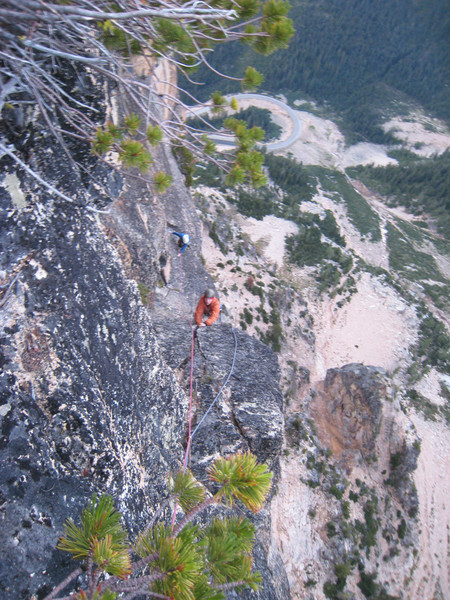
The sunshine came out for only a few minutes while we were on route, but we had sunshine in our souls.
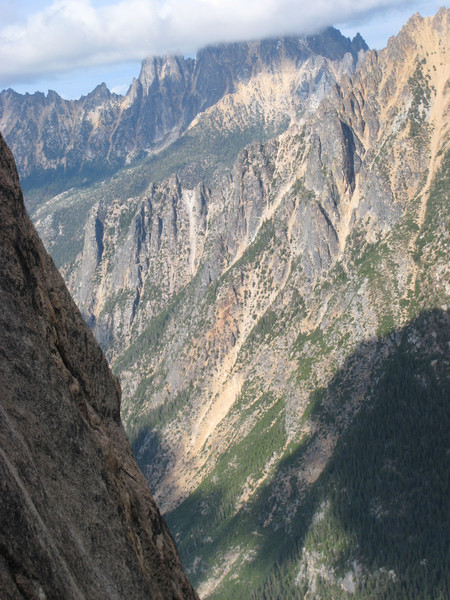
I'd say this is up there with CBR and the Grand Wall as one of the best routes I've done anywhere. Kudos to Burdo. It's totally doable for an 11- climber, particularly if you have a 20-something ropegun to lead the hard moves. Wish I'd drawn some of those leads, but I still had a blast and now have a reason to go back.
Gear Notes:
Mostly small gear. Doubles to #2 camalot, with extra finger sized pieces. One #3 camalot is useful for the last moves before the slot roof on p3. No larger gear needed.
Approach Notes:
Take Blue Lake trail to SEWS shoulder. Stash packs and approach shoes in tree, and take descending traverse along E wall. A large gully appears and then you cross it to get to the start. See pics
-
IMO, knot in dyneema doesn't sound good. Options include: double it. triple it. set up a sliding x between pieces. if suitable (e.g. multipitch) use clove hitches or figure eight in rope to allow rope to help equalize pieces leading in to a power point. Equalizing is most important for less than perfect placements. Bomber pieces need not always be equalized.
-
work routes from the top down before the red-point attempts.. it helps a lot. Just go from the last bolt/rest stance ect.. to the top then from one lower and so on. After that work on red pointing, pulling the rope after each attempt.
This is what I've read as well, and it makes good sense for reasons too verbose to include here. But how do you put it into practice? How do you get to the upper section of lead-only routes (which is most) without having climbed or french-freed the lower parts? I am a noob in this as well but would like to improve.
-
Both can be easily done as day trips
Unless you're feeble like me.
Negative self talk will hold you back from reaching your full potential. Read Performance Rock Climbing or spend time with John Frieh.
-
E Ridge direct on Forbidden is great, no ice games.
Sahale Arm is fun, easy.
Both can be easily done as day trips, or camp in Boston Basin and do both.
-
There are a lot more variables in play in the mountains than at most rock climbing crags. We each develop our own risk profile. It's probably best to climb with people who have similar risk profiles and to generally refrain from imposing our own ideas about risk on other adults as they should be free to make their own choices.
"Fall mountains, just don't fall on me......."
"I'm the one that's got to die when it's time for me to die. So let me live my life the way I want to"
If 6 Was 9.
James Marshall Hendrix.



[TR] Sloan SW Face - Fire on the Mountain (FA/FFA) 8/30/2009
in North Cascades
Posted
Yes. The face climbing potential is mind-blowing.
You'd have to bolt by hand because this is in the Henry Jackson wilderness, thank goodness.
It felt good to not leave anything behind on our ascent.